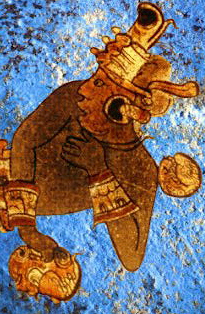Maya blue facts for kids
Quick facts for kids Maya blue |
|
|---|---|

A warrior with Maya blue on the background
|
|
| Color coordinates | |
| Hex triplet | #73C2FB |
| Source | http://www.colorhexa.com/73c2fb |
Maya blue (called azul maya in Spanish) is a special bright blue color. It's a type of pigment, which is a material that gives color. Ancient people in Mesoamerica, like the Maya and Aztec, made and used this amazing blue.
Contents
How Was Maya Blue Made?
Maya blue is made from two main things. One is a blue indigo dye. This dye comes from the leaves of a plant called anil (or Indigofera suffruticosa). The other main part is a special type of natural clay called palygorskite. Scientists have also found tiny amounts of other minerals in it.
When Was Maya Blue Used?
People started using Maya blue around the year 800. It was still used much later, even in the 1500s. For example, some paintings in old churches in Mexico used this color. A painter named Juan Gerson used it in his artworks. These paintings show a mix of local and European art styles. The way to make Maya blue was lost in Mexico after a while. But in Cuba, people were still using it as late as 1830.
Why Is Maya Blue So Strong?
Maya blue is incredibly tough! Even after a long time and bad weather, paintings with Maya blue have not faded. The color can resist strong chemicals like acids. Scientists tested its strength against many things. They found it's a very strong pigment. It can only be destroyed with very intense acid treatments.
Because it lasts so long, Maya blue has inspired new ideas. Scientists are now trying to create new colors. They use the special structure of Maya blue as a guide. One new color they made is called Maya Violet.
How Do We Know What Maya Blue Is Made Of?
Scientists began studying Maya blue in the 1950s. They used special tools to look at its chemical makeup. They found it was a mix of palygorskite clay and indigo. The indigo likely came from the añil plant.
In 1993, a Mexican expert named Constantino Reyes-Valerio figured out how to make Maya blue again. He was a historian and a chemist. He studied old writings and looked at ancient paintings up close. He also used modern scientific tools. His work helped us understand the exact recipe. It involves different clays and the añil plant.
After his recipe was shared, more research happened. Scientists from Europe worked with Reyes-Valerio. They used many advanced techniques. These studies helped us learn even more about Maya blue. They looked at its history, how it was made, and its amazing properties.
How Was Maya Blue Used in Ancient Cultures?
Maya blue was very important in ancient Mesoamerican cultures.
- It was used as a color in many artworks. This includes sculptures, murals (wall paintings), and possibly textiles (fabrics).
- It also colored ancient books called Mesoamerican codices. For example, many pictures in the Florentine Codex use Maya blue.
- The color helped prove that an ancient book, the Grolier Codex, was real. It is now known as the Codex Maya of Mexico.
- Some research suggests Maya blue was used in special ceremonies. At Chichén Itzá, it might have been used to paint people during rituals for the rain god Chaac.
- Maya blue was seen as a very valuable color. It was linked to the center of a flame, which was considered to hold the most heat and spiritual energy.
Images for kids
-
Microscopic image of a mural at Teotihuacán
-
Mexican Colonial Painting by Juan Gerson where Maya blue was used: The technique disappeared in the early colonial period.
See also
 In Spanish: Azul maya para niños
In Spanish: Azul maya para niños




